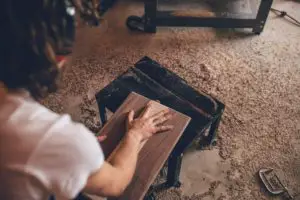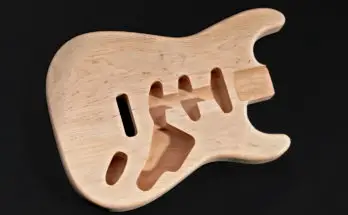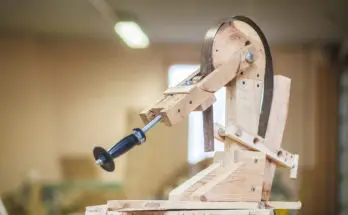One of the common complaints from people in woodworking is nasal or sinus issues that appear after working in their shop. It’s often asked is the issue related to the actual woodworking, or weather, or something in the shop.
Can woodworking cause a sinus infection? Yes, if you don’t have the proper equipment in place, there is a high likelihood that the dust from the wood you were cutting is causing your nasal flareup. Unfortunately, a sinus infection isn’t the most serious health concern related to saw dust while woodworking.
Take a look below and we will explore some of the dangers of inhaling wood dust and what you can do to prevent any future issues.
Common Symptoms
Symptoms of breathing more wood dust than you should typically make themselves visible quickly. After working in the shop for a few hours with no dust collection in place, it is common for someone to feel the effects of the wood dust within just a few hours.
Sinusitis, also known as a “sinus infection”, is defined as “inflammation of the lining membrane in any of the hollow areas (sinuses) of the skull around the nose.” Short term symptoms that are likely to appear include: stuffy nose, headache, watery eyes, sneezing, and coughing. These symptoms begin to appear once something airborne (wood dust) impedes the drainage of the sinus cavities.
Long Term Impact
Cancers
It wasn’t until the Occupational Safety and Health Administration (OSHA) began looking at the risks of inhaling wood dust in 1985 that more attention began to be cast upon the problem. Since that time more and more studies have been completed to determine what requirements should be put into place to protect the individuals in this industry.
In 2010, a widow named Deborah Mitchell of Carnary Island, Essex, United Kingdom was awarded £375,000 due to the loss of her husband, Ken, to nasal cancer. Ken, had worked as an apprentice at a cabinet making shop in the late 1960′ and early 1970’s. Three decades had passed before symptoms had begun appearing that something might be wrong. By that time, it was too late. Ken battle the disease for 4 years before passing away.
Sino-nasal Cancer
This is one of the rarest forms of cancer. According to cancer.org, there are approximately 2,000 casea of this form of cancer diagnosed each year. However, a study in the United Kingdom found that approximately 23% of the people diagnosed with this form of cancer had previous experience as a woodworker at some point in their life.
If found early, cancer.org estimates 5 year survival rate for the disease is about 63% but drops to approximately 35% if found in later stages.
Lung Cancer
Lung Cancer is the second most diagnosed form of cancer in the United States. It’s estimated that approximately 230,000 people will be diagnosed with the disease in 2018. A study in conducted in the late 1980’s found that a person who had worked around wood dust was significantly more likely to develop this form of cancer.

Problem Woods
Interestingly, different woods provide different levels of toxicity. For an in-depth look at which woods are higher or lower on the scale, please take a look at wood-database.com. Based on their research the following woods contain the highest levels of toxic wood dust:
- Australian Cashew Nut
- Bosse
- Western Red Cedar
- Milky Mangrove
- Mulga
- Rosewood
- Yew
Pine and Oak which are two of the more common woods in the United States were scored 2 of out 4 stars for toxicity.
Spalted Woods
Spalted woods are defined as a wood that has seen discoloration due to a fungus that has infested it. Most commonly, these are found in dead trees. This type is wood has become popular for those who use lathes to create bowls and other ideas because of their unique look. Though the wood is beautiful to look at, extra precautions should be taken when working with this type of wood. The fungus that is present in these woods can significantly increase the risk of nasal issues, including cancers. It is highly recommended that anyone working with spalted wood use a respirator and have adequate workshop ventilation.
Dust Size Explained
If you have ever purchased a filter for your home’s AC, you’ve probably noticed each filter is given a MERV rating. MERV ratings start at a 1 and can go as high as 20. The higher the rating (and typically the price), the more air particles that are prevented from passing through it.
The same rating scale is used when purchasing dust prevention filters for your workshop as well. These particles are measured in microns. A micron is a unit of measure used for microscopic items. To give some perspective, there are 25,400 microns in an inch. The thickness of a human hair is approximately 50 microns.
To offer some perspective, a rating of 1 will block most carpet fibers from passing through. Level 8 is going to block most mold spores and a 14 is going to block tobacco smoke. When looking for a filter for the workshop, it is recommended that you purchase one with a MERV rating as high as you can afford. It’s common to find filters up to a 15 rating.

Prevention
There are numerous pieces of equipment available to help prevent the amount of dust that enters your nasal passages and lungs while working with wood. Often, people feel that the only item they need to protect themselves is a simple small shop vacuum to suck up the saw dust once they are finished with their project. This is actually opposite from what they should be thinking. A vacuum should be the last line of defense to protect yourself. If you are like most people, vacuuming is one of the last steps you take before turning in for the night. By then, the dust particles have floated around your workshop and may have already entered your lungs. Below we will look at some of the most common types of equipment used in the industry to help protect you from these hidden dangers.
Air Filtration System – these machines typically hang from the ceiling of your workshop. They have a motor connected to a fan that draws air in one side, forces it thru a filter and then out the other. An entry level filtration system can start at around $150 and go up from there. Typically, these units will work with no electrical changes to your workshop, though buyers should verify before purchase. Check out my review on the WEN 3410. It is a very impressive machine that is extremely budget friend. I have been very impressed with it’s performance. You can find my review here.
Dust Collector – these units are very similar to a regular vacuum, but on steroids. They come with much larger motors that increase suction which then in turn push the air thru thicken filters before pushing it out into your work area. Many woodworkers will build entire collection systems in their shop with tubes that interconnect each of their saws to one central dust collector. This allows them to use a single unit to vacuum up saw dust. The cost of an entry level dust collector can start around $125 and go up into the thousands depending on the requirements of your setup. One thing to check before purchasing a collector is to ensure the electrical requirements work with the setup in your shop.
Respirator – A respirator is a mask that is worn over the face. It seals off the mouth and nose areas requiring air to pass thru filters before being inhaled into the body. These are typically rated in 3 classes: FFP1, FFP2 and FFP3. These rating indicate the filters block 80%, 94% and 99% of particles, respectively. A basic respirator can be found at any big box store. I have had great results with this particular model by Breath Buddy.
Down Draft Table – these tables are unique in that their table top is covered with holes. Under the table top, you will find the area under it to be hollow. Then a vacuum or dust collector is attached to the hollow portion which creates a down draft effect so that while the woodworker is sanding, grinding or cutting on a piece of material, the dust is sucked downward into the collection system. Small table top tables can be found for around $150, but the price can go up quickly based on the needed size. There are also plenty of DIY versions that can be found online.
Vacuum – Most people with woodworking equipment should have a vacuum at the very least. Nowadays, shop vacs come with a wide range of features and well as in different sizes. The sizes and features can quickly impact the cost of a unit, but it’s not uncommon to find a decent vac starting at $50 at a big box store. As stated before, a vacuum should NOT be your only method for cleaning the air in your shop. A vacuum’s job should be thought of as “pick up wood chips.” It does NOT “pick up wood dust particles.”
Conclusion
Buying a dust collection tool is probably one of the most boring purchases a woodworker can make. In reality, the machine will just sit in the corner and wait for you to click the on or off button. Though it’s not a sexy purchase, it’s probably the most important purchase someone can make for their shop.
Adding each of the pieces of equipment mentioned above will significantly ramp up the level of protection within your workshop. Do yourself and your family a favor, and spend $300 on at least a basic setup to help clean the air you will be working in.




